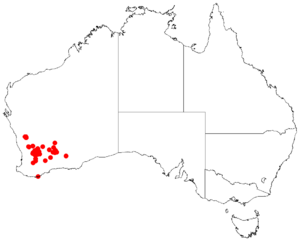Zig-zag wattle facts for kids
Quick facts for kids Zig-zag wattle |
|
|---|---|
| Scientific classification | |
| Genus: |
Acacia
|
| Species: |
merinthophora
|
 |
|
| Occurrence data from AVH | |
The Acacia merinthophora, also called the zig-zag wattle, is a special type of tree or shrub. It belongs to the Acacia family. This plant only grows naturally in western Australia, meaning it's found nowhere else in the world.
What Does It Look Like?
This zig-zag wattle can grow as a tree or a shrub. It usually reaches a height of about 1.5 to 4 meters (5 to 13 feet). Its branches spread out or hang down. They are wavy and have ridges.
Instead of regular leaves, this Acacia has special parts called phyllodes. These phyllodes are long and thin, like cords. They are yellow-green and smooth. Each one is about 7 to 25 centimeters (2.8 to 9.8 inches) long and only about 1 millimeter wide. They have four main lines running along them.
The zig-zag wattle blooms from May to September. It produces bright yellow flowers. These flowers grow in small groups, either alone or in twos or threes. The flower-heads are shaped like small cylinders. They are about 6 to 10 millimeters long and 5 to 10 millimeters wide. They are packed with golden flowers.
After the flowers, seed pods grow. These pods are straight and thin, up to 13 centimeters (5.1 inches) long. They are about 2 to 2.5 millimeters wide. Inside, there are shiny brown seeds. Each seed is about 3 to 4 millimeters long. They have a creamy yellow tip called an aril.
How It Got Its Name
The zig-zag wattle was first officially described in 1904. A botanist named Ernst Georg Pritzel gave it its scientific name. He worked with another botanist, Ludwig Diels, on a study about plants in Western Australia.
The plant's specific name, merinthophora, comes from ancient Greek words. Merinthos means 'cord' or 'string'. Phoreo means 'to carry' or 'to wear'. This name describes the plant's long, thin, cord-like phyllodes.
Where Does It Grow?
This wattle plant is found in several regions of Western Australia. These include the Wheatbelt, Great Southern, and Goldfields-Esperance areas. You can find it from places like Koorda in the north to Coolgardie in the east. It also grows near Narrogin in the west.
It likes to grow in low-lying areas, on hillsides, and in sandy plains. It prefers rocky, sandy soils, often near large granite rocks. It is usually part of shrubland communities, which are areas with many shrubs.

